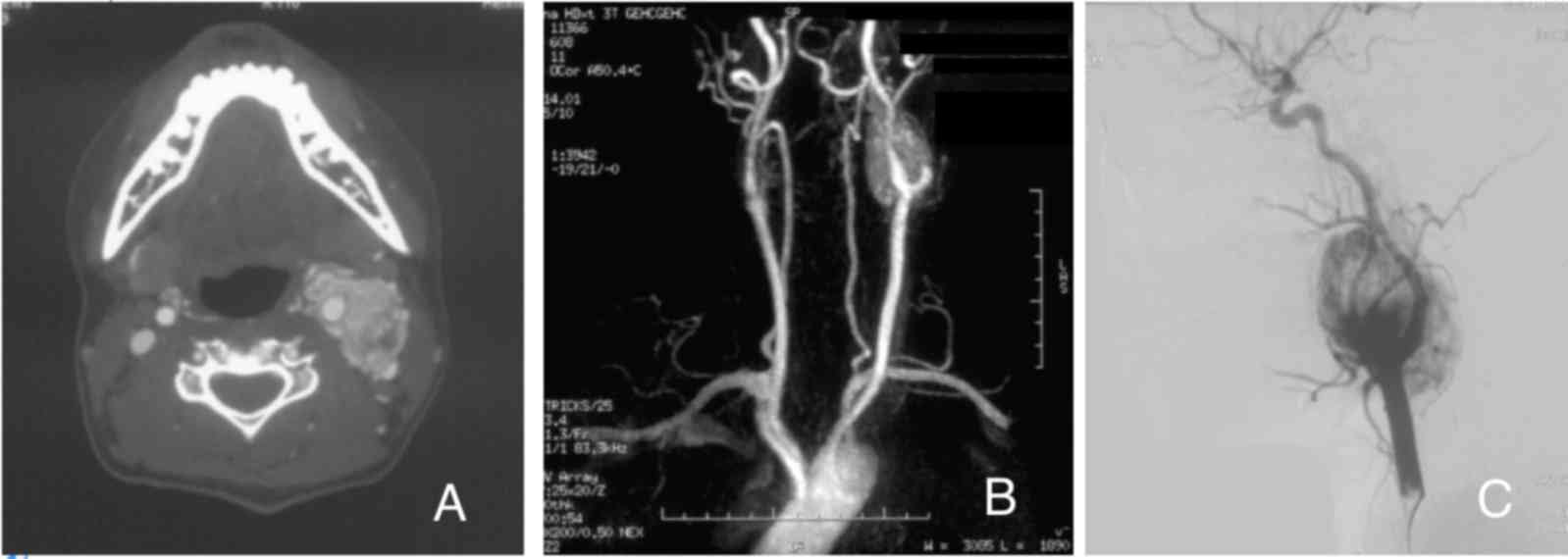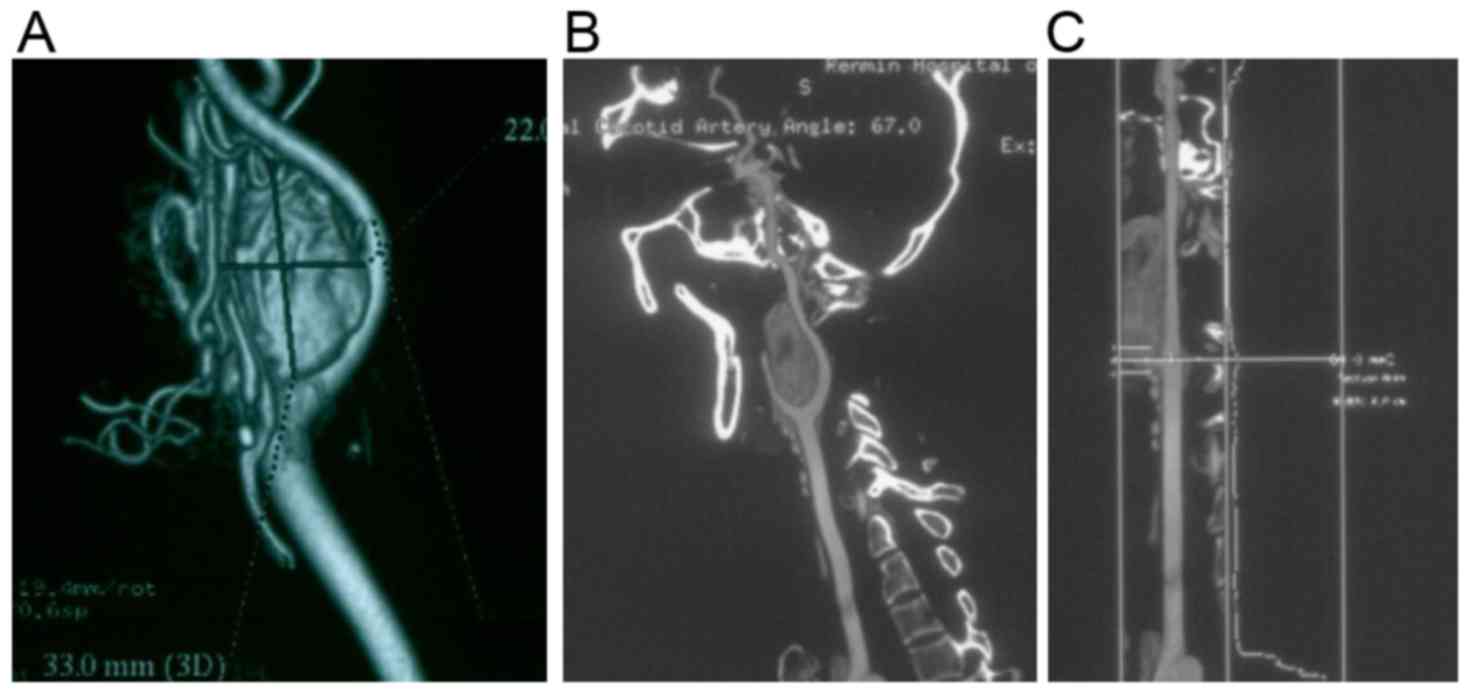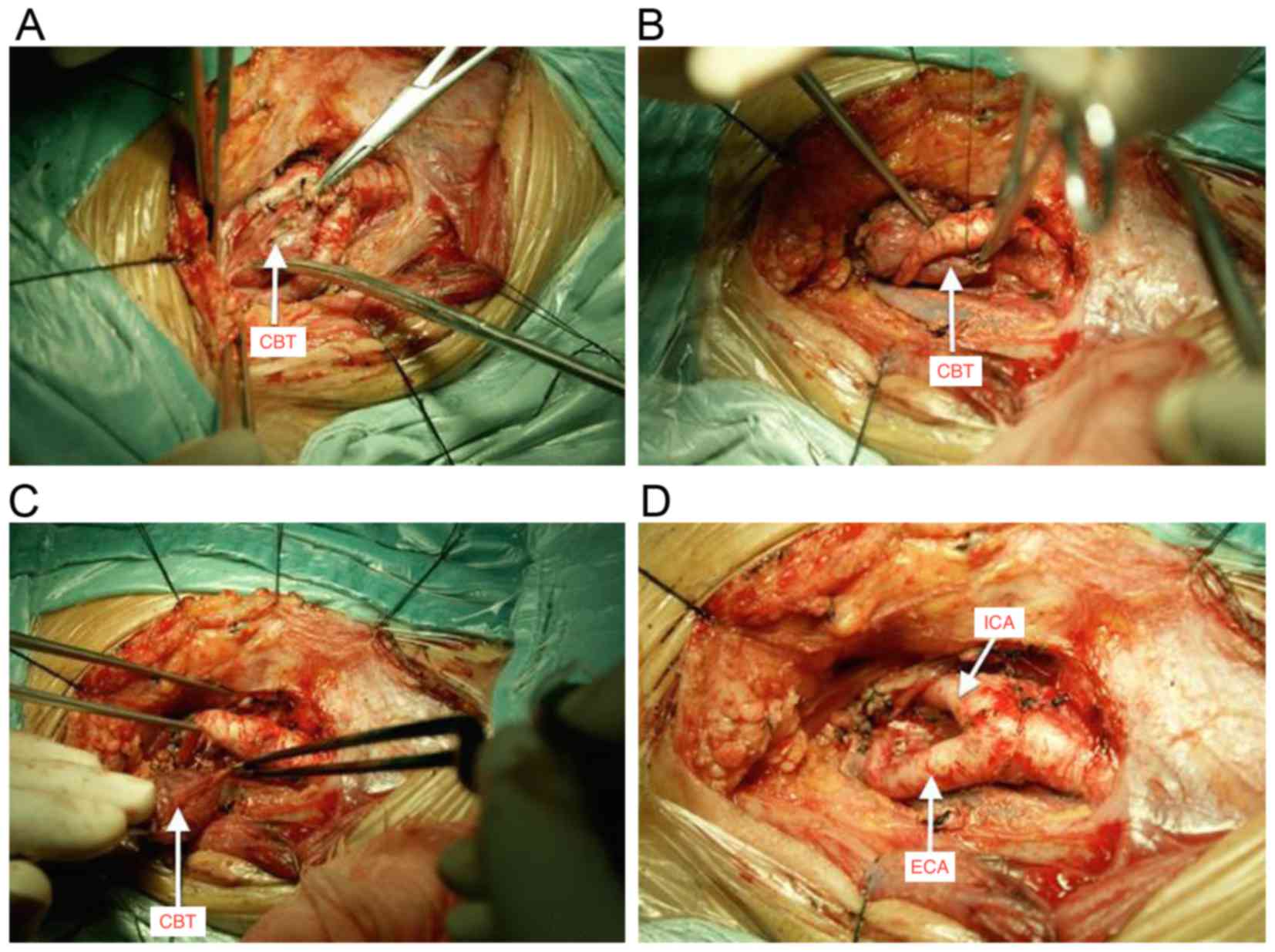Diagnosis and surgical treatment of carotid body tumor: A retrospective analysis of 58 patients
- Authors:
- Published online on: July 15, 2017 https://doi.org/10.3892/ol.2017.6582
- Pages: 3628-3632
Abstract
Introduction
Carotid body tumor (CBT) is a slow-growing neuroendocrine neoplasm that is usually localized at the bifurcation of the common carotid artery (1,2). CBT is an infrequent neoplasm in clinical practice, rarely malignant, which accounts for ≤0.5% of all head and neck tumors with no obvious gender predominance. Approximately 10% of affected cases may be bilateral (3). The diagnosis of CBT remains a challenge, as its manifestations are not typical. Generally, surgical resection is regarded as the first line of treatment for CBT (4,5). It is challenging to treat as the carotid body is a highly vascular structure situated in the adventitia of the posteriomedial aspect of the carotid bifurcation (6). Therefore, clinicians understanding of the vascular anatomy of this region is critical for the diagnosis and treatment of CBT, and important factors affecting the success of surgical resection include the ability and experience of the surgeon. The present study, through a review of 58 patients (62 lesions) with CBT managed by the same surgeon, aimed to investigate the diagnosis and treatment of CBT.
Materials and methods
Patients
A retrospective analysis was performed on patients with CBT who were surgically treated in the Department of Otolaryngology Head and Neck Surgery, Renmin Hospital of Wuhan University (Wuhan, China) between October 2003 and October 2013. A total of 58 patients (26 male and 32 female) were included, with an age range of 31–65 years, an average age of 42.8 years and a disease duration ranging from 3 to 84 months. The protocols used in the present study were approved by the Ethics Committee of Renmin Hospital of Wuhan University. Written informed consent was obtained from all patients subsequent to a detailed explanation of the study.
Imaging techniques
All the patients received computed tomography (CT) and magnetic resonance imaging (MRI) scans. CT was performed to localize the position of the tumor mass, and to display the adherence of tumor to the peripheral tissues. CT angiography was performed in 25 cases, and MRI angiography was performed in 15 cases to visualize the morphology of the blood vessels. Digital subtraction angiography (DSA) was performed in 20 patients (Figs. 1 and 2).
The brain ischemic tolerance of each patient was monitored using a rheoencephalogram (REG). Approximately 2 weeks prior to the surgery, carotid compression was performed on the affected side(s). At 1 day prior to the surgery, DSA examination was performed in 12 patients with Shamblin grade III tumors to determine the establishment of cerebral collateral circulation.
Surgical technique
Laterally inclined incisions were made along the anterior border of the sternomastoid muscle under general anesthesia (7). On visualizing the common carotid artery, a series of anatomical structures were separated in order, including the cranial nerve, accessory nerve, the common carotid artery and the internal and external carotid veins. On this basis, the common carotid artery and the proximal end of the tumor artery were blocked using sterilized bands to stop the blood flow. Subsequently, sole resection of CBT, resection of CBT and external carotid artery, and resection of CBT and common carotid artery were performed using bipolar electrocoagulation under a surgical microscope according to the adherence of the tumor mass to the artery. Reconstruction of the common carotid and external carotid arteries was performed in patients who underwent resection of these arteries (Fig. 3).
Results
Patient characteristics
The 58 patients included 26 men and 32 women (mean age, 42.8 years; age range, 31–65 years), and disease duration ranged from 3 to 84 months. Unilateral lesions were identified in 54 patients, with 26 on the left side, and 28 on the right side, and bilateral lesions were identified in 4 female patients. No family history of CBT was reported for any of the patients.
Among the patients, 38 (65.5%) presented to the Department of Otolaryngology Head and Neck Surgery at Renmin Hospital of Wuhan University, due to a tumor mass in the neck, 12 (20.7%) presented with headache and a tumor mass in the neck, and 6 patients (10.3%) presented with hoarseness combined with headache and a tumor mass in the neck. The remaining 2 patients (3.4%) were transferred to our department due to massive bleeding caused by resection of a tumor mass in the neck. Of the 62 lesions, 17 were categorized as Shamblin I, 33 were categorized as Shamblin II, and 12 were categorized as Shamblin III (Table I).
Complete resection of CBT was performed in all 58 patients (62 lesions). The tumor masses ranged in size from 3 to 12 cm, with a median of 5.6 cm. Surgical duration was 3–8 h. The average bleeding volume of patients with lesions of Shamblin grade I and II was 300–600 ml, with a median of 485 ml. Patients with Shamblin grade III lesions had an average bleeding volume of 400–1,200 ml, with a median of 780 ml. No tracheostomies were performed. Pathological analysis indicated that the CBTs were benign. Hospitalization lasted for 10–14 days (median, 12.4 days; Table II).
Postoperative complications
No hemiplegia was observed in any of the patients. Hoarseness and bucking were observed in 2 patients with Shamblin III lesions (Table III). These complications were eliminated 1 month subsequent to the administration of hormone therapy and nerve-nurturing strategies (including dexamethasone and mecobalamine). No relapse or mortality was observed during the 6–84 months of follow-up.
Discussion
DSA is considered to be an important technique for the diagnosis of CBT as it can define the profile of the tumor, including location, size and the presence of intratumoral blood vessels. In addition, DSA is usually used before CBT surgery with the aims of aiding transarterial embolization therapy and reducing the occurrence of intraoperative hemorrhage (8–10). However, there are limitations (11). For example, the adherence of the tumor mass to the peripheral tissues is poorly displayed by DSA prior to surgery. Also, ectopic embolism and vascular rupture are usually reported as the technique is invasive. Additionally, a high risk of cardiac arrest was observed in patients with carotid body hypersensitivity (9).
Currently, CT, CT angiography (CTA) and MRI are used for the diagnosis of CBT as these techniques are able to define the size and margins of the tumor mass, and the adherence of the tumor mass to the peripheral tissues (12,13). In particular, a previous study showed that the hemodynamic analysis obtained using CTA contributed to the accurate evaluation of the morphology of the vascular wall and the identification of tumor invasion to the middle layer and tunica intima of the carotid wall (14). According to our previous clinical experience, we recommend complete evaluation of tumor invasion to the carotid artery prior to the surgery and, concomitantly, appropriate evaluation of brain ischemic tolerance in order to evaluate whether the cerebral collateral circulation has been established. In the present study, preoperative DSA was beneficial to the establishment of cerebral collateral circulation. In addition, hemodynamic observation of the CBT segment may contribute to the identification of vascular wall invasion. Besides the aforementioned disadvantages of DSA, the bleeding of patients undergoing transarterial embolization prior to the surgery was not obviously decreased in the present study. According to our clinical experiences, preoperative DSA and transarterial embolization are not recommended for patients with CBT.
A higher incidence of massive bleeding was observed during the preoperative biopsy as the blood vessels in the CBT were abundant. In the present study, 2 patients were transferred to the Department of Otolaryngology Head and Neck Surgery, Renmin Hospital of Wuhan University, following resection of the carotid mass at local hospitals. On this basis, we recommend that biopsy and surgery should not be performed for patients with tumor masses in the carotid triangle, unless a confirmed diagnosis has been achieved.
Currently, surgery and radiotherapy are considered the primary treatment choices for CBT. According to our clinical experiences, surgery is recommended once CBT is diagnosed. Currently, the surgical procedures of CBT are mainly based on the Shamblin classification (10), including tumor resection, tumor and external carotid artery resection, tumor resection together with vascular reconstruction (internal carotid artery) and tumor resection together with ligation of the common carotid artery. According to our clinical practice, tumor resection is the desired procedure suitable for cases that belong to Shamblin I or those exhibiting tumors with a small size and a limited blood supply. For Shamblin II and III cases, if the carotid artery lumen is well shaped, the wall boundary is clear and the blood flow is also uniform, tumor resection may be selected; however, preparation for vascular reconstruction is required. Special attention should be paid during the separation of the tumor body and blood vessels; for example, bipolar electrocoagulation should be modulated to a refined pattern, and the energy should be set at a suitable number and assisted by washing using fresh water in order to prevent thermal injury of the vascular intima. For the patients with Shamblin I and II lesions with abundant blood supply, surgical resection of CBT and external carotid artery is recommended. Tumor resection and vascular reconstruction is suitable for the patients with Shamblin grade II and III lesions, those with tumors of diameter >5 cm, or those with abundant blood supply in the tumor mass (10). According to our clinical practice, prior to surgery, preoperative evaluation of the affected region is important in order to avoid ligation of blood vessels and interruption of cerebral blood supply as far as possible, due to reduce postoperative hemiplegia.
In the present study, surgical resection of the tumor mass was performed in the majority of patients with Shamblin grade III lesions. Blood vessel transplantation or ligation was only performed in those with tumor cells invading into the middle layer of the artery and tunica intima. Resection was performed in 62 lesions, among which 52 (83.87%) underwent resection of the CBT. The internal carotid artery was well preserved in 11 lesions of Shamblin grade III lesions, with no postoperative complications. Ligation of the tumor mass and common carotid artery was performed in 1 patient with a Shamblin grade III lesion, and no ischemia of brain tissues was observed subsequent to the surgery. For the patients with bilateral CBT, staging surgery is proposed in order to guarantee cerebral blood supply. Generally, the lesion with the larger tumor mass should be treated first, and then the contralateral tumor mass should be removed subsequent to healing of the wound of the previous surgical site.
At present, surgery is preferred for the treatment of CBT; however, this remains a challenge as this type of tumor is a highly vascular mass that is often densely adherent to the vagus nerve (15). According to our clinical experience, it is recommended that the surgery is performed under microscopy in order to define the boundary of tumor mass and the vascular wall. On this basis, the incidence of vascular rupture and neural injury may be avoided. Concurrently, bipolar electrocoagulation may be used to treat the thermal injury to the vascular wall and peripheral tissues. Among the 58 patients included in the present study, 1 patient exhibited vascular rupture, and no severe complications, such as postoperative hemiplegia or permanent injury of the cranial nerves, were observed. Injury of the cranial nerves, which most of presents as injury of the vagus nerve and hypoglossal nerve, is the most common type of postoperative complication of CBT surgery. It is mainly caused by intraoperative dragging, and may be healed subsequent to conservative therapy unless the injury was permanent. In clinical practice, a deep understanding of the anatomical structure of the neck is required for the surgery. Therefore, surgery using microscopy is recommended, which is beneficial for the identification of the vascular wall and nerves. Additionally, special care should be taken to obtain a clear surgical field, and to prevent the occurrence of bleeding and injury of the cranial nerves.
Radiotherapy is an alternative management for those patients unfit for surgery, those who may not tolerate the surgery, and those who exhibit metastasis subsequent to surgery (16,17). Although the outcome of radiotherapy for CBT is satisfactory, complications subsequent to chemotherapy are usually reported, such as otitis externa, otitis media, osteoradionecrosis, cranial nerve lesion and brain injury.
In summary, surgical resection is the preferred treatment for CBT. The present study suggests that surgical resection should be performed once CBT is confirmed. The evaluation of imaging features and cerebral collateral circulation is critical for the selection of treatment methods. Injuries to the cranial nerves may be reduced with the development of microsurgery and cardiovascular surgery. Tumor resection, without reconstruction and ligation of the common carotid artery may be required for patients with Shamblin grade III tumors. Reconstruction or ligation causes potential damage to the nervous system, and is only required in patients with tumor cells invading the middle layer and tunica intima of carotid artery.
References
|
Unlu Y, Becit N, Ceviz M and Kocak H: Management of carotid body tumors and familial paragangliomas: Review of 30 years' experience. Ann Vasc Surg. 23:616–620. 2009. View Article : Google Scholar : PubMed/NCBI | |
|
Martinelli O, Irace L, Massa R, Savelli S, Giannoni F, Gattuso R, Gossetti B, Benedetti-Valentini F and Izzo L: Carotid body tumors: Radioguided surgical approach. J Exp Clin Cancer Res. 28:1482009. View Article : Google Scholar : PubMed/NCBI | |
|
Sanghvi VD and Chandawarkar RY: Carotid body tumors. J Surg Oncol. 54:190–192. 1993. View Article : Google Scholar : PubMed/NCBI | |
|
Davidovic LB, Djukic VB, Vasic DM, Sindjelic RP and Duvnjak SN: Diagnosis and treatment of carotid body paraganglioma: 21 years of experience at a clinical center of Serbia. World J Surg Oncol. 3:102005. View Article : Google Scholar : PubMed/NCBI | |
|
Rabl H, Friehs I, Gutschi S, Pascher O and Koch G: Diagnosis and treatment of carotid body tumors. Thorac Cardiovasc Surg. 41:340–343. 1993. View Article : Google Scholar : PubMed/NCBI | |
|
Tong Y: Role of duplex ultrasound in the diagnosis and assessment of carotid body tumour: A literature review. Intractable Rare Dis Res. 1:129–133. 2012.PubMed/NCBI | |
|
Ma D, Liu M, Yang H, Ma X and Zhang C: Diagnosis and surgical treatment of carotid body tumor: A report of 18 cases. J Cardiovasc Dis Res. 1:122–124. 2010. View Article : Google Scholar : PubMed/NCBI | |
|
Telischak N, Gross BA, Zeng Y, Reddy AS, Frankenthaler R, Ogilvy CS and Thomas AJ: The glomic artery supply of carotid body tumors and implications for embolization. J Clin Neurosci. 21:1176–1179. 2014. View Article : Google Scholar : PubMed/NCBI | |
|
Power AH, Bower TC, Kasperbauer J, Link MJ, Oderich G, Cloft H, Young WF Jr and Gloviczki P: Impact of preoperative embolization on outcomes of carotid body tumor resections. J Vasc Surg. 56:979–989. 2012. View Article : Google Scholar : PubMed/NCBI | |
|
Bauer AM, Smith RB and Thorell WE: Implications of carotid sinus hypersensitivity following preoperative embolization of a carotid body tumor. An indication for prophylactic intraoperative cardiac pacing. JAMA Otolaryngol Head Neck Surg. 140:459–463. 2014. View Article : Google Scholar : PubMed/NCBI | |
|
Lim JY, Kim J, Kim SH, Lee S, Lim YC, Kim JW and Choi EC: Surgical treatment of carotid body paragangliomas: Outcomes and complications according to the shamblin classification. Clin Exp Otorhinolaryngol. 3:91–95. 2010. View Article : Google Scholar : PubMed/NCBI | |
|
Tang F, Han D, Qu S, Liang J, Liu B and Huang Y: Diagnosis and management of jugulare glomus tumor and carotid body tumor. Lin Chung Er Bi Yan Hou Tou Jing Wai Ke Za Zhi. 28:612–617. 2014.(In Chinese). PubMed/NCBI | |
|
Derchi LE, Serafini G, Rabbia C, De Albertis P, Solbiati L, Candiani F, Musante F, Bertoglio C and Rizzatto G: Carotid body tumors: US evaluation. Radiology. 182:457–459. 1992. View Article : Google Scholar : PubMed/NCBI | |
|
Pacheco-Ojeda LA and Martínez-Viteri MA: Preoperative imaging diagnosis of carotid body tumors. Int Surg. 95:242–246. 2010.PubMed/NCBI | |
|
Suárez C, Rodrigo JP, Mendenhall WM, Hamoir M, Silver CE, Grégoire V, Strojan P, Neumann HP, Obholzer R, Offergeld C, et al: Carotid body paragangliomas: A systematic study on management with surgery and radiotherapy. Eur Arch Otorhinolaryngol. 271:23–34. 2014. View Article : Google Scholar : PubMed/NCBI | |
|
Künzel J, Koch M, Brase C, Fietkau R, Iro H and Zenk J: Treatment of cervical paragangliomas: Is surgery the only way? Am J Otolaryngol. 35:186–191. 2014. View Article : Google Scholar : PubMed/NCBI | |
|
Sur RK, Krawitz HE, Malas S, Donde B and Levin CV: Carotid body tumour-a case for radiotherapy? S Afr J Surg. 33:106–109. 1995.PubMed/NCBI |












